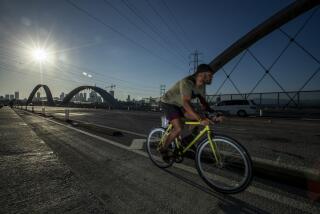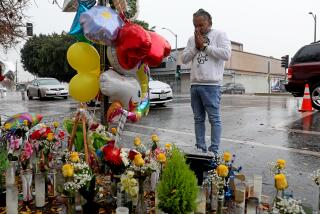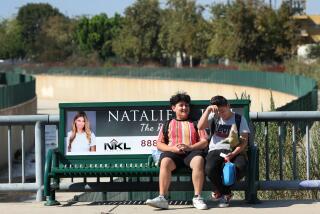Mayor Garcetti outlines plan to spruce up L.A. streets
For 12 years, Eric Garcetti had the good fortune of representing Hollywood, Silver Lake, Echo Park and Atwater Village on the City Council just as a dramatic revitalization of those neighborhoods was taking hold.
On Tuesday, the new mayor, who campaigned on a pledge to spread urban revival across the rest of L.A., started outlining how he hoped to do it.
Invoking Aristotle and Charles Dickens, Garcetti launched his Great Streets Initiative, a plan to turn the main thoroughfares of up to 40 neighborhoods into more lively and pedestrian-friendly destinations.
The models are not just Sunset Junction in Silver Lake and Glendale Boulevard in Atwater Village, he said, but also Abbot Kinney Boulevard in Venice, Ventura Boulevard in Studio City, 6th Street in San Pedro, 1st Street in Boyle Heights and South Robertson Boulevard in Pico-Robertson.
“There, you find communities that are anchored by emergent or emerging great streets, with places to eat, places to shop, places to downward-dog,” said Garcetti, a yoga enthusiast referring to the signature pose.
In his first executive directive as mayor, Garcetti created a Great Streets Working Group. Officials in eight city agencies will recommend streets to target for new medians, sidewalk repairs, bus stops, police patrols, bike corrals, pocket parks and business improvement districts.
“And while we’re at it, let’s add some sculptures and murals as well,” Garcetti told a downtown audience at a Transit Oriented Los Angeles conference sponsored by the Urban Land Institute.
How the city will pay to spruce up boulevards in an era of chronic budget shortfalls is unclear. Los Angeles no longer has a redevelopment agency, which often paid for streetscape improvements until it succumbed to state budget cuts. Also, channeling additional city money into selected streets could come at the expense of others, and City Council members are known to jealously guard their turf.
For now, Garcetti can take comfort in the relative ease of the project’s vision phase. About 12 years ago, older stretches of his district had “lost their swagger,” but “acts of urban acupuncture” attracted investors, he told the urban planners.
“Dickens once called this the key of the streets, and we found that key and unlocked prosperity,” he said. People were searching for a sense of community, the mayor said.
“In fact, it was Aristotle who said that people came to the city to preserve life, but the city exists for the good life. People were looking for the good life — for places to meet, to shop.”
Garcetti said he would pay close attention to aesthetics that affect a neighborhood’s livability and vibrancy. “I believe that design matters,” he said.
The proposal is renewing concerns about gentrification, where rents and property values rise so high that working-class residents can’t afford to remain in a neighborhood.
“Everyone wants their neighborhood to look nicer, and certainly our streetscapes in Los Angeles need improving,” said Becky Dennison, co-director of the Los Angeles Community Action Network, a group that advocates for low-income residents in downtown and South L.A. “But we want that to happen for existing communities, not the way it happened in Hollywood and Silver Lake.”
Reimagining L.A.’s big boulevards isn’t a new idea. In 1993, Con Howe — the city’s newly installed planning director — argued that the city’s strength is its residential neighborhoods, but its weakness is its deteriorating commercial corridors, many of them lined with aging mini-malls and lifeless storefronts.
Twenty years later, Howe said those thoroughfares have improved, sometimes dramatically. Colorado Boulevard in Eagle Rock, 1st Street in Boyle Heights and Wilshire Boulevard in Koreatown and Miracle Mile have benefited from new development and more bustling pedestrian activity, said Howe, who is now managing director of the CityView Los Angeles investment fund.
“Most of the corridors still remain blighted in the city. There’s hundreds of miles of them and it takes decades for hundreds of miles of anything to evolve,” Howe added. “But I cannot think of a corridor that is worse than it was in 1992, 1993, and I can think of many that are better.”
Councilman Mike Bonin, who represents such neighborhoods as Westchester, Mar Vista and Venice, said a number of streets in his district are “far short of great.” But one, he said, is at the top of his list for Garcetti to focus on: Lincoln Boulevard, which runs north from Los Angeles International Airport.
“It’s supposed to be the scenic route, and it isn’t at all scenic,” Bonin said. “It doesn’t have consistent design standards. It’s not pedestrian friendly. It’s not bicycle friendly. It’s an ugly street and you’d be hard pressed to find someone in my district who disagrees with that.”
More to Read
Start your day right
Sign up for Essential California for news, features and recommendations from the L.A. Times and beyond in your inbox six days a week.
You may occasionally receive promotional content from the Los Angeles Times.








